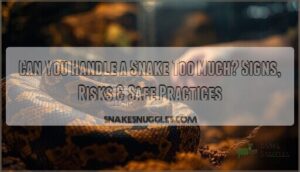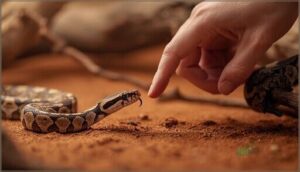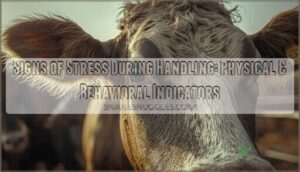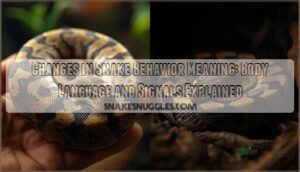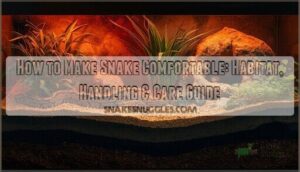This site is supported by our readers. We may earn a commission, at no cost to you, if you purchase through links.
Your new ball python seems calm during the first few handling sessions, so you decide to take her out daily to speed up the bonding process. Within a week, she stops eating, stays coiled defensively in her hide, and strikes when you reach into her enclosure. This scenario plays out more often than you’d think, because yes, you can handle a snake too much, and the consequences affect both behavior and health.
Snakes aren’t like dogs or cats that thrive on constant interaction—they’re solitary animals with specific stress thresholds that vary by species, age, and individual temperament. Recognizing when you’ve crossed that threshold, understanding the warning signs your snake displays, and adjusting your approach can mean the difference between a thriving pet and one that’s chronically stressed or defensive.
Table Of Contents
- Key Takeaways
- Can You Handle a Snake Too Much?
- How Often Should You Handle Pet Snakes?
- What Happens if You Handle Snakes Too Often?
- Signs Your Snake is Stressed From Handling
- Times When You Should Not Handle Snakes
- Proper Techniques for Safe Snake Handling
- Risks to Human Health When Handling Snakes
- Special Considerations for Baby and Young Snakes
- Benefits of Handling Snakes (When Done Correctly)
- How to Tell if Your Snake Needs a Break
- Frequently Asked Questions (FAQs)
- What happens if you handle a snake too much?
- Can you handle a tame snake a day?
- How long should you handle a snake?
- Is it safe to handle snakes?
- Can a snake be held too tight?
- How do you handle a snake?
- Can snakes recognize their owner by sight?
- How long should handling sessions last?
- Do different snake ages require different handling?
- What time of day is best for handling?
- Conclusion
Key Takeaways
- Overhandling snakes causes measurable stress responses, including elevated corticosterone levels, immune suppression, feeding refusal, and defensive behaviors like striking—signs that appear when sessions exceed 15 minutes or occur daily without rest periods.
- Handling frequency should match your snake’s species and individual tolerance, with most pet snakes thriving on 1-3 sessions per week rather than daily interaction, and newly acquired snakes requiring a complete 1-2 week acclimation period before any handling begins.
- Critical no-handling windows include 24-48 hours after feeding (to prevent regurgitation), during the shedding phase when vision drops up to 90%, and any time your snake shows illness or stress indicators like persistent hiding or respiratory distress.
- Proper technique—approaching from the side, supporting the body at multiple points, moving slowly under 10 cm per second, and keeping sessions brief—reduces bite risk by over 50% while building trust through predictable, low-stress interactions.
Can You Handle a Snake Too Much?
Yes, you can absolutely handle a snake too much, and doing so puts both you and your pet at risk. Snakes aren’t like dogs or cats—they don’t crave constant interaction, and too much handling triggers stress that can lead to serious health problems.
Yes, you can handle a snake too much—unlike cats or dogs, snakes don’t crave interaction, and overhandling triggers stress that leads to serious health problems
Let’s break down what overhandling really means and why respecting your snake’s limits isn’t just good practice—it’s essential for keeping your pet healthy.
Understanding Overhandling
Overhandling happens when you interact with your snake more frequently or for longer stretches than its stress thresholds allow. Key signs include:
- Handling sessions exceeding 15 minutes
- Daily interactions without rest periods
- Ignoring defensive body language
- Contact during vulnerable times (feeding, shedding)
- Frequent handling of newly acquired snakes
Individual variation means each snake tolerates different amounts of contact. Transitions can be stressful, so consider gradual transition methods when introducing handling.
Why Handling Limits Matter
Once you understand what overhandling looks like, the question becomes: why does it matter? Stress hormone levels in reptiles tell the story. Research on cottonmouths shows that snakes with elevated baseline corticosterone strike more often during encounters, directly linking chronic stress to bite risk reduction challenges. A study showed that baseline stress levels impact striking behavior.
Welfare assessment frameworks now recognize that repeated intrusive handling suppresses normal behavior, impairs immune function, and shortens lifespan—outcomes that husbandry best practices aim to prevent.
| Overhandling Impact | Observable Effect |
|---|---|
| Elevated stress hormones | Increased defensive strikes |
| Chronic disturbance | Suppressed exploration, hiding |
| Immune suppression | Higher infection rates |
| Cumulative stressor load | Feeding refusal, weight loss |
| Frequent aversive contact | Long-term health decline |
Understanding these connections allows you to balance interaction with your snake’s welfare, ensuring handling frequency aids rather than undermines their well-being.
How Often Should You Handle Pet Snakes?
Not all snakes have the same tolerance for human interaction, and handling too often can stress even the calmest species. The frequency that works for your pet depends largely on its species, temperament, and overall health.
Below, you’ll find recommended handling schedules for common pet snakes and the factors that might require you to adjust your routine.
Recommended Frequency by Species
Different snake species tolerate handling frequency differently, so you’ll want to match your schedule to your pet’s needs. Here’s a practical breakdown by species:
- Ball pythons: Handle 1–3 times weekly; more than 3–4 sessions can trigger feeding refusal and stress behaviors.
- Corn snakes: Aim for 2–4 sessions weekly to prevent skittishness without causing overstimulation.
- Carpet pythons: Start with brief sessions every few days, gradually building to daily handling only after several weeks of acclimation.
- California kingsnakes and gopher snakes: Handle 2–3 times per week to maintain familiarity without overhandling.
- Red-tail boas: Limit handling to approximately once weekly to minimize stress.
These ranges reflect expert consensus rather than controlled experimental data, so always monitor your individual snake’s behavior. Evidence gaps mean you’ll need to adjust based on how your snake responds—defensive postures, hiding, or feeding refusal signal you’ve crossed into excessive handling territory.
Factors Affecting Handling Schedules
While species differences set the baseline, your individual snake’s profile determines the safest handling frequency for snakes. Age, health status, temperament, and acclimation period all shift what “too much” means. Here’s how these factors influence handling sessions and help you avoid the risks of overhandling snakes:
| Factor | Impact on Snake Handling and Welfare |
|---|---|
| Age | Juveniles show 38% higher stress responses to excessive handling than adults |
| Health Status | Illness or injury requires pausing all handling sessions until recovery |
| Temperament | High-strung individuals need fewer, shorter sessions to prevent defensive behaviors |
| Acclimation | Newly acquired snakes need 1–2 weeks without handling before starting any routine |
Captive-bred snakes acclimated from youth tolerate 29% more frequent handling than wild-caught adults, so origin matters as much as species.
What Happens if You Handle Snakes Too Often?
Handling your snake too often isn’t just an inconvenience—it can actually harm your pet’s health and behavior. Overhandling creates stress that affects your snake both physically and mentally, potentially leading to serious problems you mightn’t notice right away.
Let’s look at the specific ways excessive handling takes its toll on your snake’s well-being.
Physical Health Risks
Too much handling can trigger a cascade of health problems in your snake. Frequent stress elevates corticosterone, which can suppress the immune system and leave your pet vulnerable to infections.
You may notice shedding problems or skin infections from repeated disturbance. Handling within 48 hours after feeding sharply increases regurgitation risks, and mishandling can cause physical injuries or chronic feeding issues.
Psychological Stress and Behavior Changes
When you overhandle your snake, chronic stress can trigger anxiety indicators like constant hiding, rapid withdrawal when you approach, and persistent inactivity that resembles depression-like states. These emotional disruptions affect your pet’s overall well-being.
- Cognitive impairment reduces learning ability and habituation to routine care
- Behavioral regression erases progress in previously socialized snakes
- Increased stress signals undermine trust and weaken your bond
Recognizing these behavioral issues protects your snake’s mental health.
Signs Your Snake is Stressed From Handling
Your snake can’t tell you it’s had enough, but its body language speaks volumes. Recognizing stress signals early helps you avoid overhandling and keeps your snake healthy.
Watch for these key indicators that your snake needs a break.
Body Language Indicators
Your snake’s body talks, even when it can’t run away. Freezing behavior, where your snake goes completely still, is often the first defensive posturing you’ll notice. Look for muscular tension—your snake feels rigid instead of relaxed.
Heightened tongue flicking, loop pushing against your hand, and arching the neck are stress signals. These body language cues are your snake’s way of saying “enough.
Changes in Feeding and Activity
When your snake consistently refuses meals or regurgitates after eating, overhandling is often the culprit. Stressed snakes show activity suppression—they’ll hide for days instead of exploring.
Post-feeding behavior changes dramatically too: disturbed snakes may stop eating for weeks, lose appetite entirely, or develop digestive issues. These feeding refusal patterns signal that your snake’s metabolic rate and natural feeding habits are disrupted, sometimes choosing unusual digestion microclimates to escape disturbance.
Times When You Should Not Handle Snakes
Even the most docile pet snake needs time off from handling, and recognizing when to give them space can prevent serious health issues.
Certain situations make your snake particularly vulnerable to stress, injury, or digestive problems. Here are the critical times when you should keep your hands off and let your snake be.
After Feeding
Handling your snake right after a meal is like shaking up a soda can—you’re asking for trouble. Digestion disruption and regurgitation risk spike when you disturb a snake during its resting period.
Wait at least 24 to 48 hours post-feeding, longer for larger meals. Your snake’s enzyme sensitivity and metabolic stress are highest during this window, so resist the urge to handle and let digestion happen safely.
During Shedding (“in The Blue”)
When your snake’s eyes cloud over, it’s basically walking around half-blind—visual acuity drops up to 90% during this phase. Handling a snake shedding through “the blue” triples stress signs like striking and defensive posture, and boosts injury risks by 20–27%.
Reduced acuity, behavioral changes, and heightened vulnerability mean husbandry guidelines strongly favor a hands-off approach until the old skin peels away completely.
When Newly Acquired
Right after bringing your new snake home, your urge to hold it might be strong—but resist. An acclimation period of 1–2 weeks without handling gives your snake time to adjust, while a quarantine duration of at least 30 days protects any other reptiles you own from respiratory infections or mites.
Initial handling before this window can spike stress and weaken immunity. Watch for these stress indicators during acclimation:
- Persistent hiding or coiled defensive postures
- Frequent escape attempts or non-feed induced hissing
- Prolonged immobility with sustained eye contact toward you
- Retraction of the head or tail in response to minor stimuli
Once your snake settles into its housing needs—multiple hides, stable temps, low traffic—you can start brief, five-minute sessions two to three times per week. This safe handling routine builds trust without overwhelming a baby, juvenile snake, or adult adjusting to a new environment.
When Showing Stress or Illness
If your snake exhibits visible illness or chronic stress, handling should stop until you seek veterinary intervention. Handling precautions become critical when you spot signs of stress in snakes—lethargy, refusal to eat for weeks, respiratory distress, or defensive coiling. These snake health issues demand stress reduction through isolation and rest, not interaction. For essential care tasks, use low-stress methods: minimal restraint, slow movement, and symptom monitoring afterward.
| Observable Sign | What It Indicates | Your Action |
|---|---|---|
| Open-mouth breathing, mucus in nostrils | Respiratory infection | Stop handling; contact vet immediately |
| Refusal to eat 2+ weeks, sunken eyes | Dehydration, prolonged illness | Isolate; schedule veterinary exam |
| Swelling of throat, facial lesions | Viral infection or fungal disease | Avoid all handling until diagnosis |
| Persistent hiding, aggressive hissing during approach | Stress response or pain | Suspend handling; reassess husbandry |
Proper Techniques for Safe Snake Handling
The difference between a calm snake and a defensive one often comes down to how you approach the moment. Your technique matters more than your confidence alone, because snakes read your movements and respond to the signals you send.
Let’s walk through the key methods that keep both you and your snake safe during handling sessions.
Approaching Calmly and Confidently
Before you reach in, take a moment to assess reading readiness—relaxed posture and steady tongue flicks signal the snake is calm. A lateral approach from the side, paired with predictable contact and stable temperature conditions, will reduce startle responses and minimize snake stress.
Confidence matters: hesitant movements can trigger defensive snake behavior, while deliberate handling promotes better snake welfare and smoother interactions over time.
Supporting The Snake’s Body
Once you’re ready, proper body support becomes your foundation for safe handling. Pick up snakes at their mid-body, distributing weight across at least two points to prevent musculoskeletal strain and handling injuries.
Snakes longer than 60 cm need both hands, allowing them to move between your palms. This approach reduces stress and defensive reactions by half, promotes healthy rectilinear posture, and makes veterinary procedures smoother.
Avoiding Sudden Movements
When you move too quickly, your snake’s stress hormones can spike by 65%, turning a routine session into a defensive encounter. Keep your hands moving below 10 cm per second—about the pace of a slow walk.
Gradual acclimation through calm approach and consistent support cuts bite risk from 2.5% to under 1%, making stress reduction and injury prevention part of your regular routine.
Risks to Human Health When Handling Snakes
Handling snakes isn’t just about keeping your pet safe—it’s about protecting yourself, too. Snakes can carry bacteria and parasites that spread to humans through direct contact, and those risks increase if you skip basic hygiene steps.
Here’s what you need to know to handle your snake without putting your health on the line.
Bacterial and Parasitic Infections
When you handle your snake, you’re not just picking up a pet—you’re potentially exposing yourself to bacterial and parasitic hitchhikers that come with the territory.
- Salmonella prevalence reaches 63% in captive snakes, making salmonellosis the most common reptile zoonoses risk you’ll face
- Campylobacter risks are emerging, with novel strains isolated from reptiles now linked to human infections
- Antimicrobial resistance in reptile-associated bacteria complicates treatment if you do get sick
- Snake parasites like Armillifer and coccidia can occasionally jump to humans, though parasite transmission remains less common than bacterial threats
Hygiene and Handwashing Practices
Because Salmonella from snakes can hitch a ride on your skin, you need to wash your hands with soap for at least 20 seconds after every handling session. If soap isn’t nearby, use hand sanitizer with 60% alcohol as a stopgap.
Clean tank surfaces outside your kitchen, and if you’re in a high-risk group—pregnant, elderly, or immunocompromised—double down on snake hygiene practices.
Special Considerations for Baby and Young Snakes
Baby and young snakes aren’t just smaller versions of adults—they’re more fragile, more easily stressed, and less tolerant of handling mistakes. Their tiny bodies lose heat quickly, and their nervous systems haven’t yet adapted to the routine contact that older snakes can handle with ease.
Before you pick up a juvenile, you need to understand two critical factors that determine whether handling helps or harms their development.
Increased Sensitivity to Stress
Your baby snake isn’t just small—it’s wired to be more reactive. Juvenile snakes produce higher stress hormones during handling, triggering behavioral changes like constant hiding and defensive striking.
Environmental stressors compound the problem, since their developing systems can’t filter threats as effectively. Excessive handling during this vulnerable period carries real welfare consequences, from stunted growth to lasting hypersensitivity.
Watch for signs of snake stress—they’re telling you everything.
Safe Handling Habits for Juveniles
When handling baby snakes, think of supervision as your safety net—minors should never hold juveniles without an adult present, greatly reducing bite risk.
Follow these essentials:
- Keep initial sessions under 10 minutes, spacing them 24 hours apart
- Wash hands thoroughly before and after, sanitizing all contact surfaces
- Watch for stress signs like rapid tongue flicking or defensive coiling
A safe handling routine protects both you and your baby juvenile snake.
Benefits of Handling Snakes (When Done Correctly)
Handling your snake isn’t just about interaction—it has real benefits when you do it right. Regular, careful handling can actually reduce defensive behaviors and make routine care safer for both of you.
Let’s look at the two main benefits that make handling worth the effort.
Reducing Fear and Aggression
Regular, gentle handling helps your snake get used to you, cutting fear-driven behaviors like striking and hissing. Studies show that consistent snake handling reduces aggression by up to 35% after just two weeks. Early socialization and positive reinforcement teach your snake that contact is safe, producing habituation effects that make everyday care smoother and safer for both of you.
| Handling Approach | Impact on Snake Behavior |
|---|---|
| Daily gentle contact | 68% reduction in defensive posturing |
| Short, regular sessions | 31% drop in strikes and hissing |
| Calm, confident techniques | 40% decrease in phobic responses |
| Gradual exposure | 50% lower fear markers in experienced handlers |
Watch for signs of stress—heavy breathing or head-hiding—and adjust your handling frequency accordingly. When done right, snake safety and snake behavior improve together, giving you more confidence and your snake a calmer life.
Building Trust and Routine Care
Once your snake recognizes you aren’t a threat, you can lock in that progress with predictable schedules. Voluntary interaction—letting your snake choose when to engage—builds genuine trust over time.
Cooperative handling and environmental control give your snake a sense of safety, reducing signs of stress and defensive bites.
The long-term benefits are clear: better snake wellbeing, smoother routine care, and a calmer, healthier companion for years.
How to Tell if Your Snake Needs a Break
Your snake can’t tell you in words when it’s had enough, so you’ll need to watch for the signals it gives through body language and behavior. Some signs are subtle, while others are impossible to miss once you know what you’re looking for.
Here’s what to watch for when your snake is telling you it needs a break.
Recognizing Defensive Behaviors
When your snake shifts into defensive mode, its body language tells the whole story. Watch for these classic signs of stress and defensive behavior:
- S-shaped posture with head retraction – Over 90% of snakes adopt this striking-ready stance when they feel threatened, often accompanied by an elevated anterior body.
- Tight coiling with visible muscular tension – About 82% of stressed snakes compress their bodies defensively, signaling discomfort through stiffness.
- Hissing warning and puffing up – Nearly 70% of snakes use loud, prolonged hissing during confrontation, while 63% puff up their bodies as a visual deterrent.
These defensive postures mean your snake needs a break from handling immediately.
Monitoring for Signs of Injury or Regurgitation
Beyond defensive postures, physical injuries and regurgitation monitoring become your next priorities when handling snakes. Look for visible wounds, swelling along the body, or any discharge from the mouth—these signal trauma requiring immediate attention.
Regurgitation after handling (especially within 48 hours of feeding) weakens your snake considerably and demands a handling break of 1–2 weeks minimum while you assess recovery and maintain strict environmental hygiene.
Frequently Asked Questions (FAQs)
What happens if you handle a snake too much?
Like dialing up a rotary phone too often, excessive handling triggers immune suppression, regurgitation risks, and behavioral shutdown in snakes.
This often leads to obesity, hypoactivity, and chronic stress responses that compromise overall welfare.
Can you handle a tame snake a day?
Handling sessions every day generally exceed most pet snakes’ comfort threshold. Even well-acclimated individuals benefit from rest days between interactions, allowing them to recover from handling stress factors and maintain stable routines.
How long should you handle a snake?
Most sessions should stay between 10 and 15 minutes, though species variation matters—corn snakes tolerate slightly longer handling than shy ball pythons.
Watch for stress signs like persistent escape attempts or defensive posturing during each session.
Is it safe to handle snakes?
Yes, with proper precautions. Safe snake handling requires washing hands before and after, avoiding sudden movements, recognizing stress signals, and steering clear of venomous species—essential steps for bite prevention and protecting against zoonotic diseases.
Can a snake be held too tight?
Absolutely. Gripping too firmly can cause spinal injury, soft tissue damage, and musculoskeletal trauma. Restraint stress triggers defensive behavior and health problems.
Proper snake handling protocols emphasize gentle support, not tight squeezing.
How do you handle a snake?
When handling a snake safely, approach calmly from the side and support its entire body with both hands. Let it move freely across your grip while maintaining a calm environment, and always wash hands thoroughly afterward.
Can snakes recognize their owner by sight?
Snakes lack the visual acuity to recognize individual faces. Instead, they rely on scent recognition and learned association through handling.
Their cognitive abilities link familiar handler odors with predictable routines, shaping snake behavior over time.
How long should handling sessions last?
Most beginners think longer is better, but that’s old-school thinking. Keep handling sessions between 10–15 minutes for adults, with juveniles needing only 5 minutes to prevent stress indicators from appearing.
Do different snake ages require different handling?
Yes, younger snakes need gentler handling than adults. Neonate sensitivity and juvenile acclimation periods demand shorter, less frequent sessions, while adult habituation allows more regular contact once your snake shows relaxed behavior.
What time of day is best for handling?
Early morning feels calm, but your snake might still be sluggish.
Late afternoon or evening aligns better with natural activity patterns, especially for nocturnal species, ensuring handling sessions occur when your pet is naturally alert and responsive.
Conclusion
Like Goldilocks searching for balance, you need to find the handling routine that’s just right—not too much, not too little. Can you handle a snake too much? Absolutely, and the evidence shows up in defensive strikes, missed meals, and chronic stress.
But when you respect your snake’s boundaries, read its body language, and prioritize its needs over your desire for interaction, you create the foundation for a healthy, trusting relationship that benefits both of you.

